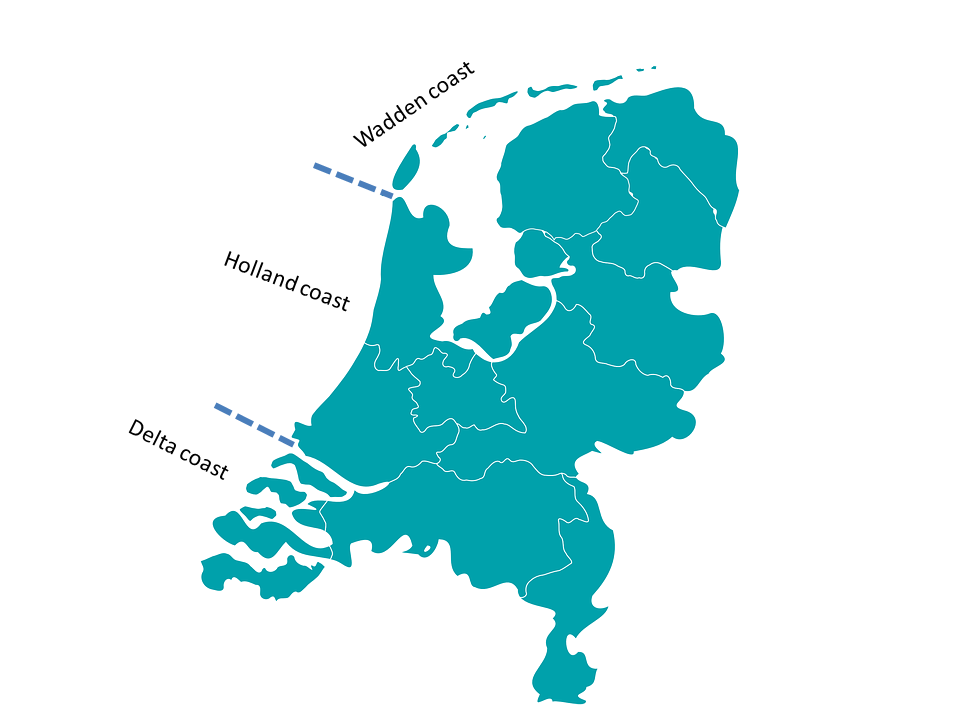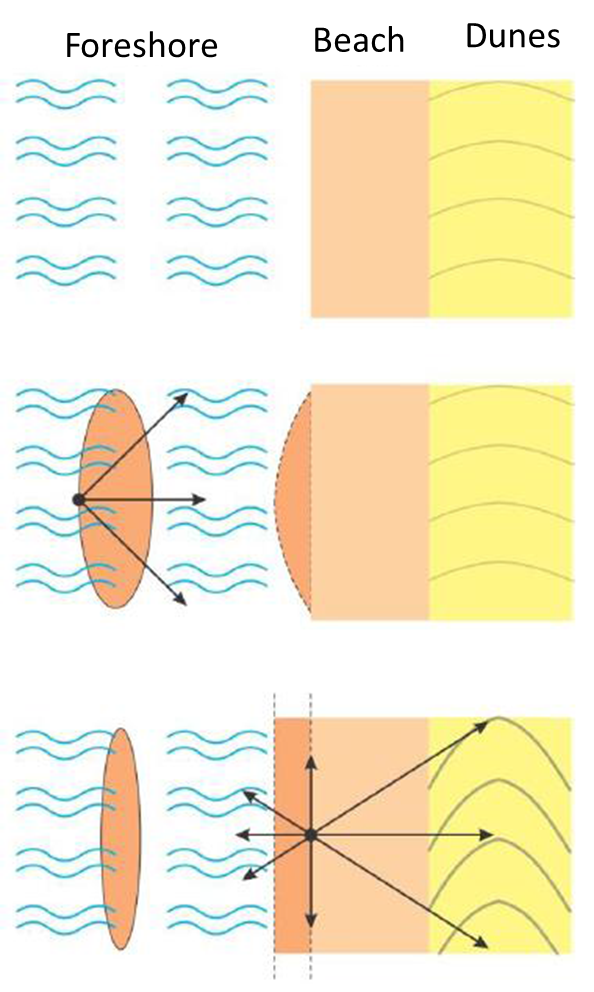Geomorphology
The majority of the Dutch coast consists of beaches and dunes and can be divided into three parts with their own characteristics:

- The Southwestern Delta coast from Zeeuws-Vlaanderen to Hoek van Holland. This coastal system is shaped by former islands in between the former estuaries of the rivers Scheldt, Rhine and Meuse and is subject to large anthropogenic influences such as the closure of most of the tidal inlets after the storm surge of 1953 and the construction of the Maasvlakte.
- The 120 km long closed Holland coast from Hoek van Holland to Den Helder. This part has a number of harbours and navigation channels affecting the net longshore transport of sediment. Across shore typically two or three breaker bars are present.
- The Wadden coast from Den Helder to the Dutch-German border. This coastal system is still affected by the construction of the Afsluitdijk (1932) and the closure of the Lauwerszee (1963).
At present, about 12 million m3 of sand is nourished to the Dutch coastal system, of which about 60% by means of relatively large shoreface nourishments and 40% by means of relatively small beach nourishments. The largest part (49%) of the 12 million m3 of nourished sand is put onto the central Dutch coast (between Hoek van Holland and Den Helder); the Wadden Sea coast and the southwestern coastal system receive 28% and 23%, respectively. The shoreface nourishments typically have a volume of 1-3 million m3 (400-600 m3/m) and are usually placed seaward from the outer breaker bar, at a water depth of 4-8 m.

Most knowledge on the geomorphological behaviour of shoreface and beach nourishments originates from data-analysis studies. Numerical modelling tools have been used successfully in hindcasting behaviour of nourishments, but do not yet have the predictive power to reliably forecast long-term effects.
A shoreface nourishment has the following two effects on the coastal system:
- The lee effect. The artificial sand bar increases wave dissipation, by which the wave height and the alongshore current onshore of the nourishment decrease. As a result, the alongshore sand transport capacity decreases here and therefore sediment accumulates upstream and erodes downstream of the nourishment. When the waves approach the shore perpendicularly, the leeside of the nourishment possibly erodes as a result of divergence of alongshore currents induced by alongshore differences in wave set-up.
- The feeder effect. This refers to the feeding of coastal system onshore of the nourishment with nourished sediment due to cross-shore sand transport processes. The net sand transport in onshore direction is enhanced by the nourishments, because, i) seaward suspended load decreases because the additional wave dissipation by the nourishments reduces the offshore-directed undertow and the wave-induced sediment suspension, and ii) onshore bed- and suspended load increase at the nourishment due to additional wave skewness related to the lower water depth compared to the no-nourished case.

The shoreface nourishment affects the autonomous behaviour of the breaker bars. The autonomous behaviour of the breaker bars is periodically and consists of the following phases:
- Generation near the beach,
- net migration in seaward direction through the surf zone, and
- de-generation at the edge of the surf zone.
The latter phase triggers the generation of a new breaker bar (phase 1) and the seaward migration of the now outer breaker bar (phase 2). This cycle is a cross-shore distribution of sand without a significant loss in offshore direction. The number of breaker bars (between 0 and 4) and the duration of this cycle (between 0 and 15 years) vary along the Dutch coast and are, among other things dependent on the steepness of the coastal profile.
The nourishment, placed against the outer breaker, generally re-shapes itself relatively quickly (within a few months) into a bar with a landward trough. As a result of this, the offshore migration of the original breaker bars is halted; sometimes they even temporarily migrate in the onshore direction. During this stop of offshore bar migration, the bars keep their pre-nourished dimensions.
